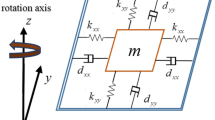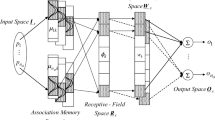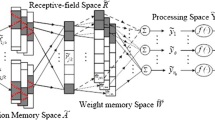Abstract
For real-world applications, the obtained data are always subject to noise or outliers. The learning mechanism of cerebellar model articulation controller (CMAC), a neurological model, is to imitate the cerebellum of human being. CMAC has an attractive property of learning speed in which a small subset addressed by the input space determines output instantaneously. For fuzzy cerebellar model articulation controller (FCMAC), the concept of fuzzy is incorporated into CMAC to improve the accuracy problem. However, the distributions of errors into the addressed hypercubes may cause unacceptable learning performance for input data with noise or outliers. For robust fuzzy cerebellar model articulation controller (RFCMAC), the robust learning of M-estimator can be embedded into FCMAC to degrade noise or outliers. Meanwhile, support vector machine (SVR) is a machine learning theory based algorithm which has been applied successfully to a number of regression problems when noise or outliers exist. Unfortunately, the practical application of SVR is limited to defining a set of parameters for obtaining admirable performance by the user. In this paper, a robust learning algorithm based on support SVR and RFCMAC is proposed. The proposed algorithm has both the advantage of SVR, the ability to avoid corruption effects, and the advantage of RFCMAC, the ability to obtain attractive properties of learning performance and to increase accurate approximation. Additionally, particle swarm optimization (PSO) is applied to obtain the best parameters setting for SVR. From simulation results, it shows that the proposed algorithm outperforms other algorithms.
Similar content being viewed by others
References
Albus JS (1975) A new approach to manipulator control: the cerebellar model articulation controller (CMAC). ASME J Dyn Syst Meas Control 97(3):220–227
Albus JS (1975) Data storage in the cerebellar model articulation controller (CMAC). ASME J Dyn Syst Meas Control 97(3):228–233
Wong Y-F, Sideris A (1992) Learning convergence in the cerebellar model articulation controller. IEEE Trans Neural Netw 3(1):115–121
Lane SH, Militzer J (1992) A comparison of five algorithm for the training of CMAC memories for learning control systems. Int Fed Autom Control 28(5):1027–1035
Cotter NE, Guillerm TJ (1991) The CMAC and a theorem of Kolmogorov. Neural Netw 5:221–228
Lee C-Y, Lin C-J, Chen H-J (2007) A self-constructing fuzzy CMAC model and its applications. Inf Sci 177(1):264–280
Hu J, Pratt J, Pratt G (1999) Stable adaptive control of a bipedal walking; robot with CMAC neural networks. In: Proceedings of 1999 IEEE international conference on robotics and automation, pp 1050–1056
Shelton RO, Peterson JK (1992) Controlling a truck with an adaptive critic CMAC design. Simulation 58(5):319–326
Horvath G (2003) CMAC neural network as an SVM with B-Spline kernel functions. In: Proceedings IMTC 2003—instrumentation and measurement technology conference, pp 20–22
Nam S-H, Oh S-Y (1999) Real-time dynamic visual tracking using PSD sensors and extended trapezoidal motion planning. Appl Intell 10(1)
Hwang K-S, Lin C-S (1998) Smooth trajectory tracking of three-link robot: a self-organizing CMAC approach. IEEE Trans Syst Man Cybern Part B 28(5):680–692
Iiguni Y (1996) Hierarchical image coding via cerebellar model arithmetic computers. IEEE Trans Image Process 5(10):1393–1401
Su S-F, Tao T, Hung T-H (2003) Credit assigned CMAC and its application to online learning robust controllers. IEEE Trans Syst Man Cybern Part B 33(2):202–213
Lee Z-J, Wang Y-P, Su S-F (2006) A genetic algorithm based robust learning credit assignment cerebellar model articulation controller. Appl Soft Comput 4(4):357–367
Su S-F, Lee Z-J, Wang Y-P (2006) Robust and fast learning for fuzzy cerebellar model articulation controllers. IEEE Trans Syst Man Cybern Part B 36(1):1–6
Vapnik VN (1995) The nature of statistical learning theory. Springer, New York
Trafalis TB, Gilbert RC (2006) Robust classification and regression using support vector machines. Eur J Oper Res 173:893–909
Cherkassky V, Yunqian M (2004) Practical selection of SVM parameters and noise estimation for SVM regression. Neural Netw 17(1):113–126
Jeng J-T (2006) Hybrid approach of selecting hybperparameters of support vector machine for regression. IEEE Trans Syst Man Cybern Part B 36(3):699–709
Üstün B, Melssen WJ, Oudenhuijzen M, Buydens LMC (2005) Determination of optimal support vector regression parameters by genetic algorithms and simplex optimization. Anal Chim Acta 544:292–305
Kennedy J, Eberhart R (1995) Particle swarm optimization. In: Proceedings of IEEE international conference on neural networks, pp 1942–1948
Coello CAC, Pulido GT, Lechuga MS (2004) Handling multiple objectives with particle swarm optimization. IEEE Trans Evol Comput 8(3):256–279
Huang C-M, Huang C-J, Wang M-L (2005) A particle swarm optimization to identifying the ARMAX model for short-term load forecasting. IEEE Trans Power Syst 20:1126–1133
Xia W, Wu Z (2005) An effective hybrid optimization approach for multi-objective flexible job-shop scheduling problems. Comput Ind Eng 48(2):409–425
Liang J-J, Qin AK, Suganthan PN, Baskar S (2006) Comprehensive learning particle swarm optimizer for global optimization of multimodal functions. IEEE Trans Evol Comput 10(3):281–295
Holmstrom L, Koistinen P (1992) Using additive noise in back-propagation training. IEEE Trans Neural Netw 3:24–38
Cichocki A, Unbehauen R (1993) Neural networks for optimization and signal processing. Wiley, New York
Lin C-S, Chiang C-T (1997) Learning convergence of CMAC Technique. IEEE Trans Neural Netw 8(6):1281–1292
Chuang C-C, Su S-F, Chen S-S (2001) Robust TSK fuzzy modeling for function approximation with outliers. IEEE Trans Fuzzy Syst 9(6):810–821
Connor JT, Martin RD, Atlas LE (1994) Recurrent neural networks and robust time series prediction. IEEE Trans Neural Netw 5(2):240–254
Author information
Authors and Affiliations
Corresponding author
Rights and permissions
About this article
Cite this article
Lee, ZJ. A robust learning algorithm based on support vector regression and robust fuzzy cerebellar model articulation controller. Appl Intell 29, 47–55 (2008). https://doi.org/10.1007/s10489-007-0080-0
Received:
Accepted:
Published:
Issue Date:
DOI: https://doi.org/10.1007/s10489-007-0080-0




